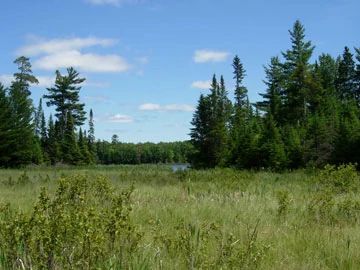Lehto Lake
No. 655

Photo by Robert Wernerehl
Lehto Lake features an extensive peatland complex associated with Randall Creek, a slow, soft, warm water stream tributary to the Bear River. From the outlet on Randall Lake to the Bear River, this seasonally navigable stream is bordered by extensive stands of northern sedge meadow and shrub swamp/fen thickets. Scattered islands of second-growth pine and paper birch occur next to the creek and out in the open bog areas. The edges of this peatland are dominated by closed-canopy black spruce swamp grading into a narrow zone of white cedar along the upland margin.
The peatlands north and west of Lehto Lake support swamp islands of dense second-growth fire-origin hemlock-white pine forest under an overstory of old paper birch. A small but outstanding old-growth hemlock stand with super canopy white pine occurs along the south shore of Lehto Lake. The lake itself is a shallow, soft water spring lake with very low transparency. A long-established beaver dam has created floating bog islands and numerous shallow bays that rim the south, west and northern shores of the lake. West Randall Lake to the north is a shallow, soft water lake that drains a large peatland to the north. Large populations of bog orchids occur on the floating mat along the lakeshore. This shore fen quickly grades into a more acidic open bog, musket, and spruce swamp. Small spruce-fir islands are scattered throughout. Lehto Lake is owned by the DNR and was designated a State Natural Area in 2012.
Very few State Natural Areas have public facilities, but nearly all are open for a variety of recreational activities as indicated below. Generally, there are no picnic areas, restrooms, or other developments. Parking lots or designated parking areas are noted on individual SNA pages and maps. If a developed trail is present, it will normally be noted on the SNA map and/or under the Maps tab. A compass and topographic map or a GPS unit are useful tools for exploring larger, isolated SNAs.
The good majority of SNAs are isolated and have few or no facilities. Some SNAs have vehicle access lanes or parking lots, but their accessibility may vary depending on weather conditions. Parking lots and lanes are not plowed during winter. Hiking trails may be nonexistent or consist of undeveloped footpaths. A GPS unit or compass and a detailed topographic map are useful tools for exploring larger SNAs.
Entrance fees: Except for Parfrey's Glen, the Cambrian Outlook in the Dells of the Wisconsin River, SNAs within State Parks and some within State Forests, all other DNR-owned SNAs do not have any admission fees. For more information, see Wis. Admin. Code NR 45 [exit DNR]. For non-DNR-owned SNAs, we are unaware of any vehicle or admission fees. However, please contact the landowner for more information.
Allowable activities: DNR-owned land
The activities listed below are generally allowed on all DNR-owned SNA lands. Exceptions to this list of public uses, such as SNAs closed to hunting, are noted above and posted with signs on the property site.
- Hiking
- Fishing
- Cross country skiing
- Hunting
- Trapping
- Scientific research (permit required [PDF])
- Outdoor education
- Wild edibles (What is this?)
- Pets (Rules)
- Wildlife viewing
Prohibited activities: all SNAs
Although a handful of sites allow activities like primitive camping (e.g. Lower Chippewa River on sand bars) or horseback riding (e.g. S. Kettle Moraine), the activities listed below are generally prohibited on DNR-owned SNAs.
- Camping and campfires
- Collecting of animals (other than legally harvested species), non-edible fungi, rocks, minerals, fossils, archaeological artifacts, soil, downed wood, or any other natural material, alive or dead.
- Collecting for scientific research requires a permit issued by the DNR
- Collecting of plants including seeds, roots or other non-edible parts of herbaceous plants such as wildflowers or grasses
- Drones: Flying-related activities, including the use of drones, hang-gliders and model airplanes, are prohibited. Permission may be issued by the SNA Program for the use of drones for educational or research purposes
- Geocaching
- Horseback riding
- Rock climbing
- Vehicles, including bicycles, ATVs, aircraft, and snowmobiles except on trails and roadways designated for their use.
For rules governing state-owned SNAs and other state lands, please consult Chapter NR 45 Wis. Admin. Code [exit DNR].
Location
Iron County. T41N-R3E, Section 25. T41N-R3E, Sections 12, 13, 25. T41N-R4E, Sections 7, 17, 18, 19, 30. 1,612 acres.
Driving directions
Access is via canoe from the boat landing on Randall Lake to Randall Creek.
The DNR's state natural areas program is comprised of lands owned by the state, private conservation organizations, municipalities, other governmental agencies, educational institutions and private individuals. While the majority of SNAs are open to the public, access may vary according to individual ownership policies. Public use restrictions may apply due to public safety, or to protect endangered or threatened species or unique natural features. Lands may be temporarily closed due to specific management activities.
Users are encouraged to contact the landowner for more specific details. The data shown on these maps have been obtained from various sources, and are of varying age, reliability, and resolution. The data may contain errors or omissions and should not be interpreted as a legal representation of legal ownership boundaries. To create your custom map where you can zoom to a specific location, please use the DNR's Mapping Application.
Lehto Lake is owned by: Wisconsin DNR
